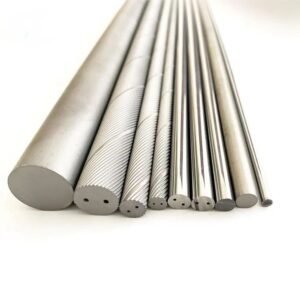Proper alignment of carbide inserts in a steel milling cutter is crucial for achieving accurate machining, smooth surface finish, and extended tool life. Misaligned inserts can lead to vibration, uneven cutting forces, and excessive tool wear, affecting both productivity and machining quality. In this article, we will explore a step-by-step approach to adjusting carbide inserts to ensure precise alignment.
1. Preparing the Cutter for Insert Installation
Before installing carbide inserts, it is essential to prepare the milling cutter properly.
1.1 Cleaning the Insert Seats and Cutter Body
🔹 Use compressed air, a soft brush, or a lint-free cloth to remove any dirt, metal chips, or coolant residues from the insert pockets (seats) and cutter body.
🔹 Inspect the seats for burrs, wear, or damage, which can prevent proper seating of the inserts.
✅ Why is this important?
Even small debris or surface irregularities can cause misalignment, leading to poor machining performance and shorter tool life.
2. Choosing High-Precision Carbide Inserts
Not all carbide inserts are created equal. To ensure proper alignment, follow these guidelines:
🔹 Use inserts from the same batch – Manufacturing variations can cause slight thickness or dimensional differences, affecting alignment.
🔹 Check insert flatness – Warped or uneven inserts will not seat properly, leading to uneven cutting.
🔹 Choose inserts with high precision – Inserts with tight tolerance specifications reduce the need for adjustments.
✅ Why is this important?
Inconsistent insert thickness can cause some teeth to cut deeper than others, leading to poor surface finish and increased tool wear.
3. Installing the Inserts Properly
Once the cutter and inserts are ready, it’s time for careful installation.
3.1 Placing the Inserts Correctly
🔹 Gently place each insert into its pocket, ensuring it sits flat against the seat.
🔹 Avoid forcing or tilting the insert, as this can create uneven contact points.
3.2 Using Proper Tightening Techniques
🔹 Insert the clamping screw gradually – Do not fully tighten one screw before placing all inserts.
🔹 Use a torque wrench to tighten the screws according to the manufacturer’s recommended torque values.
🔹 Follow a uniform tightening sequence to apply even pressure across all inserts.
✅ Why is this important?
Uneven tightening can cause inserts to tilt or shift, leading to misalignment and an inconsistent cutting edge.
4. Checking Insert Alignment and Height
Even with careful installation, it is essential to verify insert alignment before running the milling cutter.
4.1 Using a Dial Indicator for Height Measurement
🔹 Place a dial indicator on the cutting edges of the inserts.
🔹 Slowly rotate the cutter to check for height variations between inserts.
🔹 If some inserts are higher or lower than others, adjustments will be needed.
✅ Why is this important?
If inserts are not at the same height, some will engage more than others, leading to uneven wear, increased vibration, and poor surface quality.
4.2 Adjusting Insert Heights with Shims
🔹 If an insert is lower than the others, thin precision shims can be placed underneath it.
🔹 If an insert is too high, check for debris under the insert or seat damage before replacing it.
✅ Why is this important?
Shims allow for micron-level height adjustments, ensuring that all inserts cut at the same depth.
5. Inspecting Runout and Balance
Even with properly aligned inserts, checking the overall balance of the milling cutter is crucial.
🔹 Use a dial indicator to check for runout (wobbling movement) when the cutter rotates.
🔹 If excessive runout is detected, reinstall the inserts or inspect the cutter body for damage.
🔹 For high-speed applications, use a tool balancing device to ensure smooth operation.
✅ Why is this important?
A balanced cutter reduces vibration, improves tool life, and enhances machining accuracy.
6. Performing a Test Cut
Before starting full production, it is advisable to perform a test cut on a sample workpiece.
🔹 Observe the cutting sound – Unusual noise may indicate misalignment.
🔹 Inspect the surface finish – Any irregularities or tool marks may signal height differences between inserts.
🔹 Check for uneven wear on inserts – If some inserts wear faster, they might be cutting deeper than others.
✅ Why is this important?
A test cut helps identify potential misalignment issues early, preventing tool damage and scrap parts.
7. Final Inspection and Maintenance
After adjusting the inserts, regular maintenance is key to maintaining alignment and performance.
🔹 Inspect inserts for wear and replace them when necessary.
🔹 Ensure that insert screws are still securely fastened during operation.
🔹 Periodically check for buildup of metal chips or debris that could affect alignment.
✅ Why is this important?
Regular maintenance ensures consistent cutting performance, reducing costly downtime and tool replacements.
Conclusion
Properly aligning carbide inserts in a steel milling cutter is essential for achieving precision machining, longer tool life, and optimal performance. By following these seven key steps—from cleaning and installation to height adjustment and final inspection—you can ensure that your milling cutter operates with maximum efficiency and accuracy.
Would you like recommendations on high-precision carbide inserts that offer excellent alignment and stability? Contact us for expert guidance! 🚀😊





